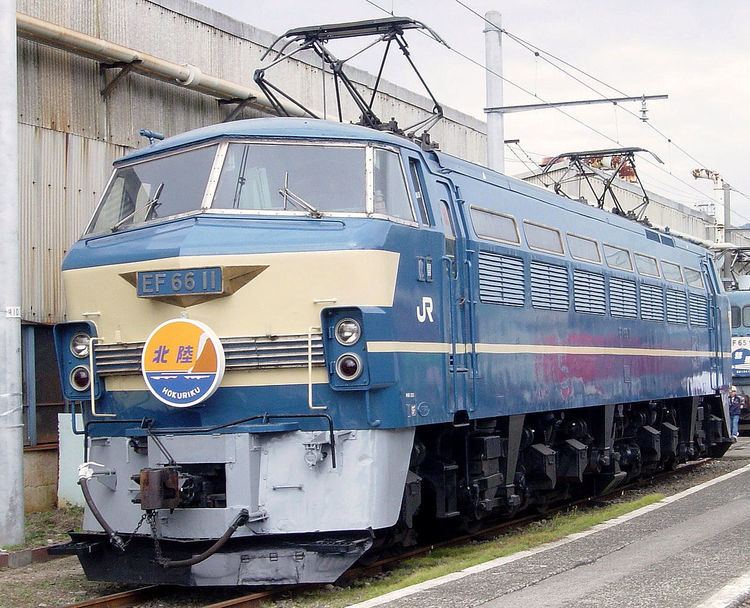Builder Kawasaki Sharyō Wheel diameter 1,120 mm (44 in) | Total produced 89 Gauge 1,067 mm (3 ft 6 in) | |
 | ||
Bogies DT133A (outer), DT134A (centre) | ||
The Class EF66 (EF66形) is a 6-axle, 3-bogied (Bo-Bo-Bo) DC electric locomotive designed for fast freight used by Japanese National Railways (JNR) and later operated by its descendents JR West and JR Freight. As of 1 April 2016, 39 locomotives remained in service, all operated by JR Freight.
Contents
Background and history
Originally these locomotives were designed for express freight on the Tokaido Main Line and Sanyo Main Line, in an attempt to counter the increasing market share being gained by road transport, by providing a fast alternative to road transport using wagons suitable for containerised freight.
The prototype (initially numbered EF90 1, later becoming EF66 901) was built by Kawasaki Sharyō in 1966; at the time with a power of 3.9 MW it was the world's most powerful narrow-gauge locomotive. The EF66 901 locomotive was retired from front-line service in 1996 and since 2001 is stored at Hiroshima Depot.
The production series of locomotives were delivered from 1968, with 55 built between 1968 and 1974.
Due to increased demand, JR Freight began building more EF66s in 1989 - this second batch of locomotives was classified EF66-100, with locomotive numbered EF66-101 to EF66-133.
Technical
The locomotives were designed to be able to haul a 1,000-tonne train at 100 km/h. Each motor has a 650 kW power output, (about 50% more powerful than the EF65). The bogies have an air suspension system to limit the impulsive forces on the track.
Of the first series of production the last 35 (i.e. 21st to 55th locomotive) were slightly different in design, externally a few changes were made - most noticeably above the drivers window a slight 'ledge' is added. Internally, these locomotives had their auxiliary electrical supply uprated from 5 kW to 90 kW.
The second series of locomotives (EF66-100) are fundamentally the same design as the first, but with slightly more modern external styling. The driver's cabs are air-conditioned.
Operations
During the JNR era, these locomotives were used for freight trains and also for passenger work - primarily hauling night trains such as the Hayabusa sleeping car limited express.
Following privatisation, JR Freight received the prototype (EF66 901) and 39 of the original series (EF66 1 to EF66 39) as well as the EF66-100 machines. Some refurbishment of the locomotives has taken place since. JR West obtained the remainder of the machines (EF66 40 to EF66 55) - a total of 16.
By 1 April 2009, 73 EF66s (including all 33 EF66-100s) were in service, with 63 owned by JR Freight (all based at Suita Depot in Osaka), and 10 owned by JR West (all based at Shimonoseki Depot).
As of 1 April 2016, 39 locomotives remained in service (six EF66-0 and 33 EF66-100 locomotives), all operated by JR Freight.
